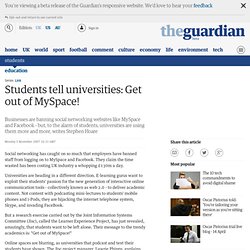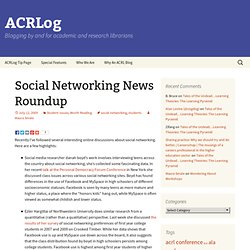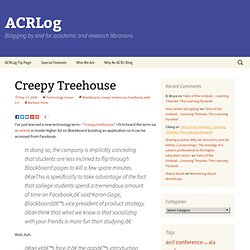

Get out of the creepy treehouse! Flexknowlogy – Jared Stein's ARCHIVED blog – update to jaredstein.org » Defining "Creepy Treehouse" Students should build their own tree house. « NINNYPANTS. A big issue in the Ed Tech world is the idea of the proverbial Creepy Tree House.

A Creepy Tree House is what a professor can create by requiring his students to interact with him on a medium other than the class room tools. Examples of this would be requiring students to follow him/her on peer networking sites such as Twitter or Face book. ( for a better definition of a Creepy Tree House see John Krutsch’s blog post “Are You Building a Creepy Tree House?” ) Although I find Creepy Tree Houses to be one of the worst things in Education Technology; this is not to say that students following their professors on these types of applications. I personally follow two of my professors, and I believe this has only helped to build my enthusiasm for the class and for continuing my studies.
This scenario may sound like the Creepy Tree House that I have just claimed to have feelings of disdain, but it is a different form of interaction. Students tell universities: Get out of MySpace! Social networking has caught on so much that employers have banned staff from logging on to MySpace and Facebook.

They claim the time wasted has been costing UK industry a whopping £130m a day. Universities are heading in a different direction. E-learning gurus want to exploit their students' passion for the new generation of interactive online communication tools - collectively known as web 2.0 - to deliver academic content. Not content with podcasting mini-lectures to students' mobile phones and i-Pods, they are hijacking the internet telephone system, Skype, and invading FaceBook.
But a research exercise carried out by the Joint Information Systems Committee (Jisc), called the Learner Experience Project, has just revealed, amazingly, that students want to be left alone. Online spaces are blurring, as universities that podcast and text their students have shown. Phipps claims that once universities start using Facebook to talk to students it will be the thin end of the wedge.
Social Networking News Roundup. Recently I’ve followed several interesting online discussions about social networking.

Here are a few highlights: Social media researcher danah boyd’s work involves interviewing teens across the country about social networking; she’s collected some fascinating data. In her recent talk at the Personal Democracy Forum Conference in New York she discussed class issues across various social networking sites. Boyd has found differences in the use of Facebook and MySpace in high schoolers of different socioeconomic statuses. Facebook is seen by many teens as more mature and higher status, a place where the “honors kids” hang out, while MySpace is often viewed as somewhat childish and lower status. What does this all mean for academic libraries? Creepy Treehouse. I’ve just learned a new technology term – “creepy treehouse.”

I first heard the term via an article in Inside Higher Ed on Blackboard building an application so it can be accessed from Facebook. In doing so, the company is implicitly conceding that students are less inclined to flip through Blackboard pages to kill a few spare minutes. “This is specifically to take advantage of the fact that college students spend a tremendous amount of time on Facebook,†said Karen Gage, Blackboard’s vice president of product strategy. “I think that what we know is that socializing with your friends is more fun than studying.†Well, duh. “Let’s face it,†the app’s introduction page says. “You would live on Facebook if you could.
Imagine a world where you could manage your entire life from Facebook — it’s not that far off! Oh, I can’t wait. A creepy treehouse is a place built by scheming adults to lure in kids. And maybe students want a different space when they’re working.